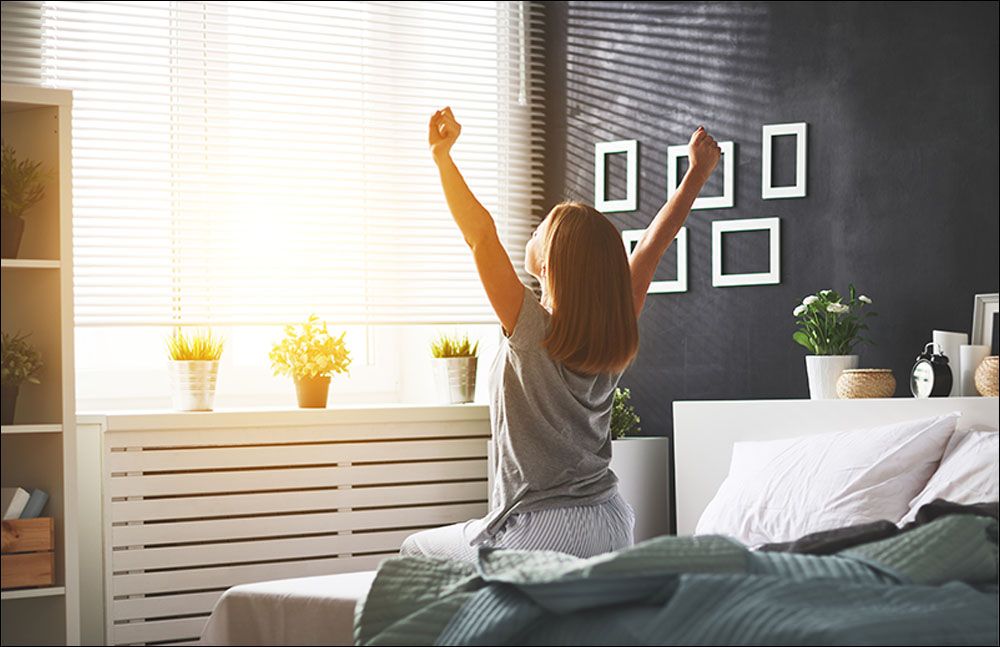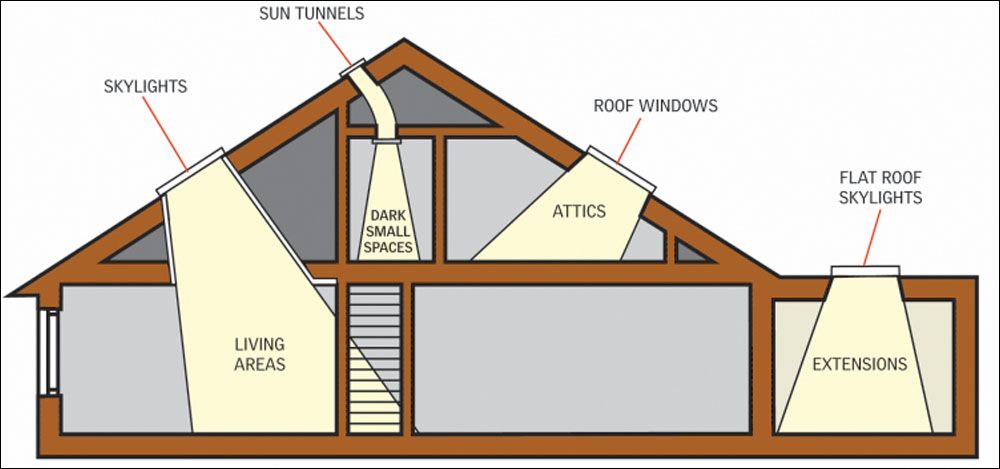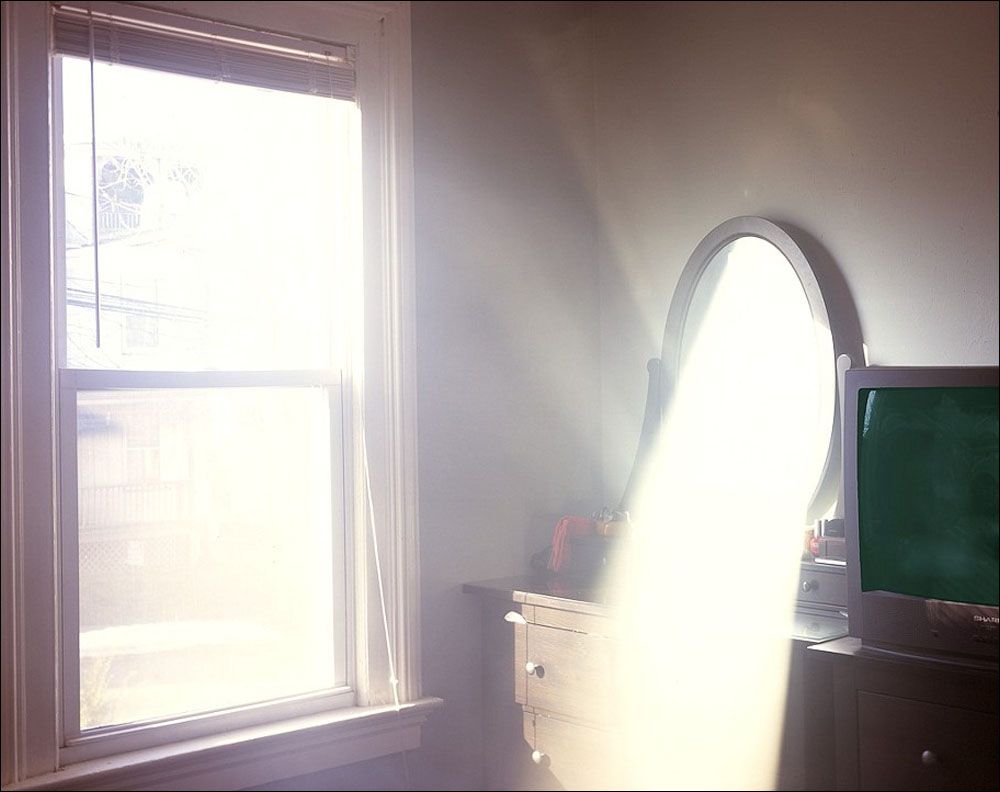Daylighting - Free Energy From The Sun

What is daylighting?
Daylighting is an architectural term. It means designing a building to let natural sunlight into a building rather than keeping it outside and having to compensate by using artificial lighting. Since I’m not an architect, I’ll stick with basic information that I’ve learned and applied in my own home. Electricity costs good money so I’m always looking for ways to spend less. Daylighting isn’t just windows. It’s everything that lets in light, enhances light, and reflects light to where you want it. Paying attention to your daylighting can allow you to maximize free, healthy sunshine while lowering your energy bills.
Paying attention to how and where the sun comes inside also benefits you in August when you want to keep it outside, repelling the heat and letting you cool your house more effectively. This essay covers some of those ways.
We’ll start with getting the sunshine inside in the first place. In addition to regular windows, other methods include door windows, skylights, solar tubes, and specialized windows such as interior windows (placed on dividing walls between rooms), transoms (the window over top of the door, both internal and external), and sidelights (the window, usually fixed glass, on one or both sides of the door). There are also light shafts (leading to below grade spaces) and basement window wells.
Unless you’ve got money to burn, you’re probably stuck with the windows you already have. However, if you’re residing your house with cement fiberboard, you have a unique opportunity to add a window or two where it would do some real good. Where does the sun shine on your house? Would a hole in that exterior wall allow in light in December thus keeping you from having to use a light fixture? Would this same hole better ventilate your house in August? This is something to discuss with your contractor but if you’re spending tens of thousands of dollars to reside your house, an additional window or two won’t add that much to your bill yet will make your house brighter, airier, and lighter.
If you live in an older house, you may have windows that someone else filled in or made smaller. Walk around your house and look at changes in the siding, especially around the windows. Sometimes, the clues are obvious. Older houses were often built with larger windows because sunshine was free. Later on, someone remuddled the house and installed smaller windows, hoping to cut down on drafts while replacing a leaky window. If you can go back to the original, larger-sized windows, you’ve got more light.
While you’re walking around your house, look at your doors. Many older homes had a fixed transom over the front door along with sidelights. Frequently, previous homeowners covered over the glass with paint or plywood. Scrape the paint (if you’re lucky) or remove the plywood and replace the glass. Instant light. Your glass store can recommend sturdier glass if you are concerned about someone smashing the glass and breaking into your house, which is probably why someone replaced the glass with plywood in the first place. Double-pane glass will cut down some of the heat loss, the other reason the previous homeowner replaced the glass with plywood.
Exterior transoms and sidelights can be retrofitted, but this is not an easy task, unless you’re residing the house and even then, you may not be able to because of how your house was constructed. You won’t know until the contractor opens the walls.
Once you’ve looked over your windows, the next way to let direct light inside is with skylights and solar tubes. Skylights, essentially giant holes in the roof, let sunshine pour in. Rooms with skylights are lit like operating rooms when the sun is up and there’s no cloud cover. Adding one is not a do-it-yourself project.

What you can add, relatively easily, are solar tubes. These are small skylights with a dome on the roof, a circular glass plate in your ceiling, and a connecting shaft made of one of two materials: highly polished sheet aluminum (the brighter option and also harder to retrofit) or not nearly as highly polished, flexible aluminum tubes that resemble giant dryer vents.
Both options add natural light where previously you had none. They need a direct access between the hole in the roof for the dome and where the glass ceiling plate goes, normally through unused attic space. If you build a box around the tube to protect it, you can run a tube through a room or a closet to a room on the first floor or even a basement. The longer the tube, the more costly and harder to install it becomes. You also get less light.
We installed four solar tubes in our house. Two in the kitchen, glass only, one in a bathroom (glass and vent), and one in the upstairs bathroom (glass, vent, and light fixture). They work like a dream. All three rooms, previously dim even at high noon, now glow with sunshine. We haven’t had any problems with leaks either. We added our solar tubes when we had the roof redone so it was all jobbed together, making it easier for the contractor to use the shinier, sheet metal tubes.
The tubes even work at night when the moon is full. It’s not much light, but it is there.
Once you have dealt with the exterior of your house, check your interior walls. High-ceilinged older houses sometimes had transom windows over the room doors. The transom let light and air move around without compromising privacy. If you have some -- painted over or nailed shut -- scrape and unstick them. A very handy do-it-yourselfer might be able to retrofit a transom.
Interior windows let light fall from room to room. If you install one, between the studs, use two panes of frosted glass for privacy. A pane of glass fits into each side of the wall, with dead air between them. We installed an interior window between the studs in our basement. The window is located in the curtain wall that separates the finished basement from the unfinished basement. The basement window is located on the unfinished side; the interior window lets us catch this free light.
Door windows do the same: they let light move from room to room. If you replace a door, even an interior one, think about one with a glass insert. Frosted glass will ensure privacy. Glass frosting comes in a range of densities from almost opaque (you get an overall glow) to virtually clear (you can see through it but not every last detail). You can sometimes get glass insert doors down at Habitat for Humanity ReStore shop. If the door fits, but the glass is clear, you can etch it in place to obscure it. Look online about etching or frosting glass windows for directions.
You may not be able to change any of your windows or add solar tubes. However, there are other things you can do to maximize your daylight. Some of these you can do even if you are a renter.
Start by washing all your windows, inside and out. Vacuum all the screens. Window screens, if they aren’t exposed to wind and rain can become choked with dust. Clean the glass and the screen and voila! More light for the cost of elbow grease. The first time you wash all your windows, vacuum the screens, and scrub all the dirt and dead bugs out of the frames will be the hardest, dirtiest job. After that, washing once a year will keep your windows in shape. While you are cleaning your windows, replace any missing or broken panes, add glaziers’ points and putty as needed, and true-up your storm windows. If the frames need to be painted, paint them ultra-high gloss white.
Scrub out your basement window wells too. This is an even dirtier job, but it can pay huge dividends. Every paintable surface should be white, with white marble chips filling the floor of the window well itself. The goal is to be able to walk around in daylight in your below grade spaces without having to switch on a light.
Paint your ceilings with ceiling white. Nothing else. Ceiling white is paint made for ceilings. It’s a bit thicker, so it’s less likely to spatter as you roll it on overhead and has a matte finish. A clean, white ceiling will reflect light better, making the room feel lighter. No matter what the decorator tells you, don’t paint a ceiling any color other than white. If your white ceiling is becoming dingy, repaint it. Drab ceiling tiles, if primed, can be painted too. I’ve painted regular ceiling tiles and those big, insulated squares suspended in a drop ceiling. If you’ve got a popcorn ceiling, ask at the paint store. You may be able to scrape the popcorn finish relatively flat, then use a heavy, textured white paint to cover it.
The lighter the color your walls, drapes, and floor are, the lighter the room will look. Light-colored walls in general reflect incoming light better than darker colors do. High-gloss paint reflects light much better than a matte finish but it also demands far more wall preparation as every flaw will show in its mirror-like finish. The same is true of trim and cabinetry. If your kitchen reminds you of a cavern, painting those dull, dark brown cabinets with high-gloss white will really brighten up the space and be easier to keep clean. White walls are vital in a basement, both finished and unfinished. Painting white Drylok paint over raw concrete block will even do double-duty by helping to keep moisture outside, where it belongs.
You need drapes for your windows, both for privacy and to trap heat in the winter. Hang your window treatments so that the stackback is off the glass, just covering the window frame. Stackback is the amount of space the drapes occupy when they’re fully open and pulled to each side. It can be substantial. Why are you covering the glass? Keeping the stackback on the walls will also make your windows look bigger than they really are. Similarly, valances can be mounted to just cover the top of the window frame. When more glass is exposed, more light will be able to enter the room.

Add mirrors in strategic locations. Mirrors add sparkle and depth to a room. They’re easy to find too; every thrift shop has plenty and you can often find them along the side of the road, waiting for the garbage collectors. I trash-picked most of my mirrors and then repainted the frames with leftover house paint. Hang big mirrors (salvaged from old dressers) on walls that are opposite to your windows and sunlight will bounce back and forth all day. If you pay attention to where sunshine comes in, you can place a mirror on that spot on the wall, and then bounce that light down a hallway. The magic won’t work all day since the sun moves around, but you can get a boost when it does.
Add mirrors on the walls behind table lamps and behind every wall sconce and candle sconce while you’re at it. Then, when you switch on that fixture or light that hurricane lamp, you’ve doubled the light.
None of these methods will keep you from having to turn on lights after dark. What they do is keep you from using light fixtures during the day and then maximize the light you’re paying for when you do use a fixture. If you need to use less electricity, you spend less money; money you can use for something else.
Comments
Justin Patrick Moore
Mon, 10/14/2019 - 14:08
Permalink
Mirrors for House Plants
Hi Teresa. Great article. We just brought all our houseplants in for the winter, and this gave me an idea... My wife and I have so many plants it is sometimes hard to find a spot for them where the sun will hit. & it will probably come as no surprise that we are trash pickers too & have found some very cool old mirrors. Now I'm going to start thinking about where to place those mirrors to reflect some added light onto our plants. Thanks for these tips!
Teresa from Hershey
Mon, 10/14/2019 - 15:36
Permalink
I love mirrors and have them everywhere
Hi Justin. I love mirrors and have them everywhere. Bigger is better, as long as you hang them carefully so they don't fall down from the wall when the train roars by, rattling the house. Old mirror frames can be repainted with leftover housepaint (sand the plastic lightly and prime first) so you don't have to be stuck with their ugliness. If you've got enough large mirrors, you can even put them under small houseplants to reflect light up!
Justin Patrick Moore
Tue, 10/15/2019 - 09:39
Permalink
Under the plant
Cool that you got to put in those light tubes when you had your roof redone. I wish we'd thought of that when we did ours! I like the idea of putting smaller mirrors under the plants to reflect the light up. I'll be keeping my eye out for small ones in the trash & at the thrift store! Great tip.
alice
Thu, 10/17/2019 - 07:48
Permalink
Awesome
This is a great article Teresa, thank you for writing it. We need to do a lot on our house so it's perfect to have found this before we've finalized our ideas.
Teresa from Hershey
Tue, 10/22/2019 - 15:52
Permalink
Thank you!
Hi Alice,
It's definitely worth the time to research and thing before doing any kind of work on your house. Bill and I will discuss a project for years. Have you thought about developing a scrapbook of ideas that appeal to you so you don't forget a possible solution?
Teresa from Hershey